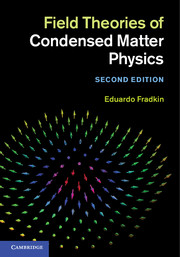Book contents
- Frontmatter
- Contents
- Preface to the second edition
- Preface to the first edition
- 1 Introduction
- 2 The Hubbard model
- 3 The magnetic instability of the Fermi system
- 4 The renormalization group and scaling
- 5 One-dimensional quantum antiferromagnets
- 6 The Luttinger liquid
- 7 Sigma models and topological terms
- 8 Spin-liquid states
- 9 Gauge theory, dimer models, and topological phases
- 10 Chiral spin states and anyons
- 11 Anyon superconductivity
- 12 Topology and the quantum Hall effect
- 13 The fractional quantum Hall effect
- 14 Topological fluids
- 15 Physics at the edge
- 16 Topological insulators
- 17 Quantum entanglement
- References
- Index
Preface to the second edition
Published online by Cambridge University Press: 05 March 2013
- Frontmatter
- Contents
- Preface to the second edition
- Preface to the first edition
- 1 Introduction
- 2 The Hubbard model
- 3 The magnetic instability of the Fermi system
- 4 The renormalization group and scaling
- 5 One-dimensional quantum antiferromagnets
- 6 The Luttinger liquid
- 7 Sigma models and topological terms
- 8 Spin-liquid states
- 9 Gauge theory, dimer models, and topological phases
- 10 Chiral spin states and anyons
- 11 Anyon superconductivity
- 12 Topology and the quantum Hall effect
- 13 The fractional quantum Hall effect
- 14 Topological fluids
- 15 Physics at the edge
- 16 Topological insulators
- 17 Quantum entanglement
- References
- Index
Summary
Preface to the second edition
I am extremely happy to, at long last, be able to present the second edition of this book. In spite of what I stated in the preface of the 1991 edition, I ended up not only writing a second edition but, in a sense, a new book. So one can say, once again, that we have met the enemy and it is us. I have been pleased that the 1991 edition of this book was appreciated by many people who found it useful and stimulating. I am really happy that my effort was not in vain.
My motivation for writing this book, in 1991 and now, was to present quantum field theory as a conceptual framework to understand problems in condensed matter physics that cannot be described perturbatively, and hence do not admit a straightforward reduction to some non-interacting problem. In essence, almost all interesting problems in condensed matter physics have this character. Two prime examples of problems of this type in condensed matter physics that developed in the late 1980s, and even more so in the 1990s, are the understanding of high-temperature superconductors and the quantum Hall effects. In both areas field theory played (and plays) a central role. If anything, the use of these ideas has become widespread and increasingly plays a key role. It was lucky that the first edition of this book appeared at just about the right time, even though this meant that I had to miss out on research that was and still is important. This was probably the only time that I was on time, as people who know me can relate. Much has happened since the first edition appeared in print. The problem of the quantum Hall effects has developed into a full-fledged framework to understand topological phases of matter. Although it is still an unsolved problem, the research in high-temperature superconductors (and similar problems) has motivated theorists to look for new ways to think of these problems, and the ideas of quantum field theory have played a central role. The concepts, and subtleties, of gauge theory have come to play a key role in many areas, particularly in frustrated quantum magnetism. The interactions between condensed matter and other areas of physics, particularly high-energy physics and string theory, have become more important. Concepts in topology and other areas of mathematics rarely frequented by condensed matter physicists have also entered the field with full force. More recent developments have seen the incorporation of ideas of general relativity and quantum entanglement into the field.
- Type
- Chapter
- Information
- Field Theories of Condensed Matter Physics , pp. xi - xivPublisher: Cambridge University PressPrint publication year: 2013



